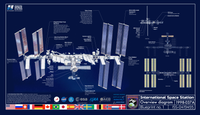波音星际客机
 在波音轨道飞行测试2号任务中对接国际空间站的星际客机 | |
| 制造 | 波音 |
|---|---|
| 国家 | 美国 |
| 运营 | 波音 |
| 应用 | 载人太空 |
| 技术指标 | |
| 航天器类型 | 载人飞船 |
| 设计寿命 | |
| 发射重量 | 13,000千克(29,000磅) |
| 乘员 | 7 |
| 尺寸 | |
| 体积 | 11 m3(390 cu ft)[4] |
| 轨道 | 近地轨道 |
| 建造 | |
| 状态 | 研发测试中 |
| 已建造 | 3 |
| 已发射 | 2 |
| 退役 | 1 |
| 首次发射 | 2019年12月20日东部时间6:36(无人) |
波音CST-100星际客机[5](英语:Boeing CST-100 Starliner,台湾作波音CST-100星际飞机[6]),或译为星际客船[7]、星际航线,是波音公司为美国国家航空航天局(NASA)的商业载人航天发展计划研制的(载人)飞船。其主要用途是运送乘客至国际空间站[8]以及诸如毕格罗这样的私人空间站[9]。
星际客机设计上类似洛克希德·马丁公司为NASA开发的猎户座飞船[10]。飞船直径为4.56米(15.0英尺)[3],比阿波罗飞船指令舱稍粗,较猎户座飞船稍细[11]。飞船能搭载多达七人的庞大机组、在轨最久七个月、最多可重复使用到第十次任务[12]。宇宙神5型、德尔塔-4、猎鹰9号和火神四型运载火箭均可发射星际客机飞船[13][14]。
星际客机于2019年12月20日从佛罗里达州卡纳维拉尔角SLC-41发射工位使用宇宙神V运载火箭[15]完成了处女航。试飞时因飞船任务的计时器错误,导致燃烧过多的推进剂,偏离了原定航线而无法到达国际空间站,并于22日提早6天返回地球。[16][17][18]
2022年5月19日,波音轨道飞行测试2号成功发射。
2024年6月5日,星际客机首次载人飞行测试成功发射[19],并于6月7日与国际空间站成功对接。本次任务原定于6月14日返航,但因飞船的氦气泄漏问题和助推器故障,波音和NASA先是将返回时间改为7月,后又延至8月。由于多次延误,波音公司在该项目上损失了超过15亿美元。它还面临NASA监察长的审查,该部门估计该航天器的每个座位成本为9000万美元,比载人版龙飞船的5500万美元高出60%以上。[20]
机组
[编辑]
美国国家航空航天局于2018年8月3日宣布了星际客机首次飞行任务成员名单[21][22]。Eric Boe最初名列其中,但于2019年1月出于“个人医疗原因”被Michael Fincke换下[23]。
- 首批测试任务成员:Michael Fincke, Christopher Ferguson, Nicole Aunapu Mann
- 首次例行任务成员:苏妮塔·威廉斯 (Sunita Williams), Josh Cassada, Thomas Pesquet, Andrei Borisenko
太空旅游
[编辑]太空探险公司称已获得授权,待飞船开始执行常规任务后即可出售乘坐星际客机前往国际空间站的船票[24]。
参见
[编辑]参考文献
[编辑]- ^ 1.0 1.1 Reiley, Keith; Burghardt, Michael; Wood, Michael; Ingham, Jay; Lembeck, Michael. Design Considerations for a Commercial Crew Transportation System (PDF). AIAA SPACE 2011 Conference & Exposition. September 27–29, 2011. Long Beach, California. 2011 [2014-05-09]. doi:10.2514/6.2011-7101. (原始内容 (PDF)存档于2013-05-01).
- ^ Carreau, Mark. Boeing Refines CST-100 Commercial Crew Capsule Approach. Aviation Week. 2013-07-24 [2014-05-08]. (原始内容存档于2014-05-12).
- ^ 3.0 3.1 3.2 Burghardt, Mike. Boeing CST-100: Commercial Crew Transportation System (PDF). Boeing. August 2011 [2014-05-08]. (原始内容 (PDF)存档于2013-05-01).
- ^ Krebs, Gunther. Starliner (CST-100). Gunthers Space Page. April 2017 [2017-04-11]. (原始内容存档于2017-05-03).
- ^ 新华社译名室. 6月6日译名发布:“星际客机”飞船. 参考消息. [2024-08-25]. (原始内容存档于2024-08-25).
- ^ 波音星際飛機首次載人飛行 發射前最後一刻又喊卡. 中央社. [2024-08-25]. (原始内容存档于2024-09-03).
- ^ “星际客船”首次载人飞行推迟至2024年. 中国载人航天工程网. 2023-08-07 [2023-10-19]. (原始内容存档于2023-10-02).
- ^ Memi, Edmund G.; Morgan, Adam K. Boeing Submits Proposal for NASA Commercial Crew Transport System (新闻稿). Boeing. 2009-09-23 [2019-12-21]. (原始内容存档于2016-03-03).
- ^ Orbital Complex Construction. Bigelow Aerospace. [2010-07-15]. (原始内容存档于2010-07-10).
- ^ Chow, Denise. New Boeing Spaceship Targets Commercial Missions. Space.com. 2010-06-25 [2019-12-21]. (原始内容存档于2017-08-18).
- ^ Clark, Stephen. Boeing space capsule could be operational by 2015. Spaceflight Now. 2010-07-21 [2011-09-18]. (原始内容存档于2018-06-22).
- ^ Boeing: Crew Space Transportation (CST) System. Boeing. [2016-01-25]. (原始内容存档于2017-01-18).
- ^ Lindenmoyer, Alan. Commercial Crew and Cargo Program (PDF). 13th Annual FAA Commercial Space Transportation Conference. February 10–11, 2010. Arlington, Virginia. 2010. (原始内容 (PDF)存档于2010-03-05).
- ^ Crew Dragon and Starliner: A Look at the Upcoming Astronaut Taxis (页面存档备份,存于互联网档案馆). Mike Wall, Space.com. 3 August 2018.
- ^ Memi, Edmund G.; Rye, Jessica F. Boeing Selects Atlas V Rocket for Initial Commercial Crew Launches (新闻稿). Boeing. 2011-08-04 [2011-10-29]. (原始内容存档于2016-03-03).
- ^ 波音「星際客機」 首發失敗 降落沙漠. Sing Tao Daily 星岛日报加拿大. 2019-12-23 [2022-11-03]. (原始内容存档于2022-11-03) (中文(台湾)).
- ^ Starliner suffers "off-nominal" orbital insertion after launch. Space News. 2019-12-20 [2019-12-20]. (原始内容存档于2024-06-06).
- ^ Sheetz, Michael. Boeing Starliner fails mission, can’t reach space station after flying into wrong orbit. CNBC. 2019-12-20 [2019-12-20]. (原始内容存档于2021-02-08).
- ^ Niles-Carnes, Elyna. NASA, Mission Partners Forgo June 2 Launch of Crew Flight Test. NASA. June 1, 2024 [June 1, 2024]. (原始内容存档于2024-06-01).
- ^ Roulette, Joey. Boeing sending first astronaut crew to space after years of delay. Reuters. May 3, 2024 [June 5, 2024].
- ^ Chavers, Alex. NASA Picks SpaceX and Boeing's First Crew. News Ledge. 2017-01-09 [2018-08-03]. (原始内容存档于2021-03-19).
- ^ NASA Assigns Crews to First Test Flights, Missions on Commercial Spacecraft. NASA. 2018-08-03 [2018-08-03]. (原始内容存档于2020-03-20).
- ^ Gebhardt, Chris. NASA announces test flight crew change for Boeing's Starliner. NASASpaceFlight.com. 2019-01-22 [2019-01-23]. (原始内容存档于2021-03-09).
- ^ Space Station Experience. [2019-12-21]. (原始内容存档于2021-03-27).
外部链接
[编辑]- http://www.boeing.com/space/starliner/ (页面存档备份,存于互联网档案馆) at Boeing.com
- YouTube上的Boeing/Bigelow Crew Space Transport Vehicle by Boeing (2010)
- YouTube上的Boeing Unveils America's First Space Taxi, Unlocks Possibilities for Future by Boeing (2014)


